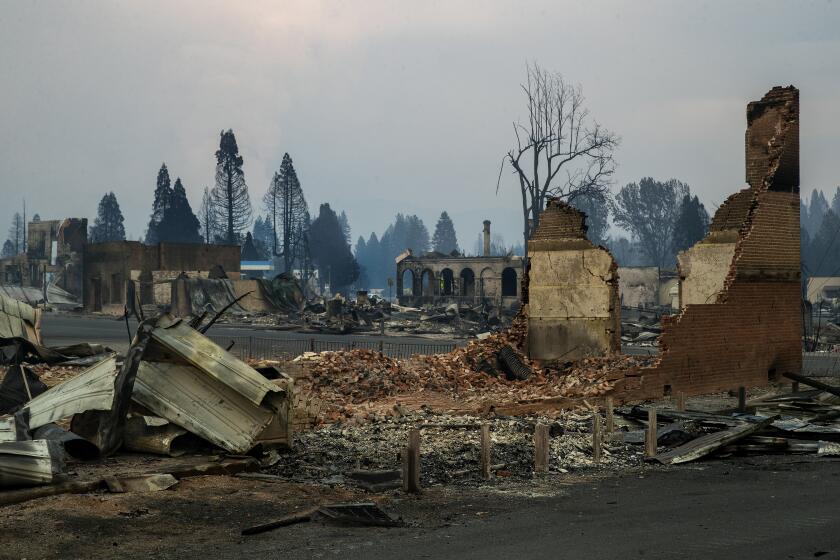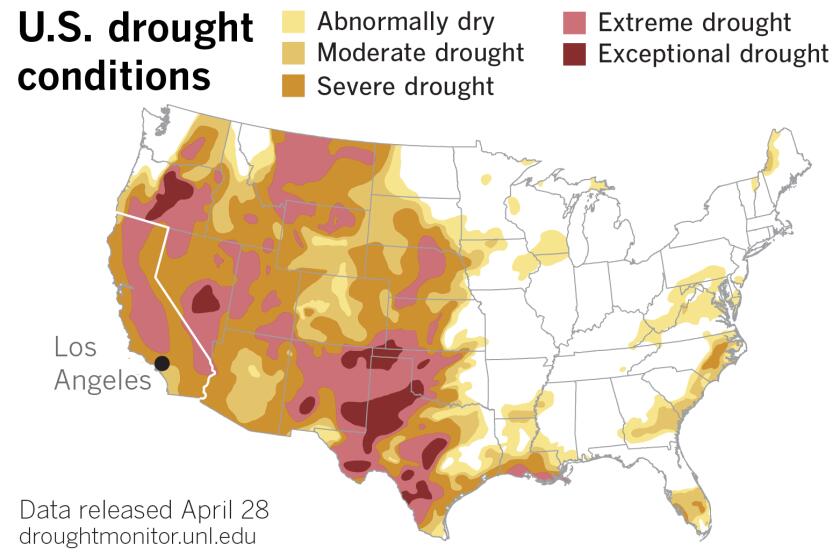Critical fire conditions coming to Northern California, forecasters say

- Share via
Low humidity and gusty winds are coming to Northern California on Thursday and Friday, significantly elevating the fire risk in the region, according to forecasters.
National Weather Service offices for the San Francisco Bay and Sacramento each issued warnings Wednesday.
“There is a risk for fire starts on Thursday into Friday given the combination of low humidity and gusty winds,” the Bay Area office said. “Remember to properly dispose of matches, ensure campfires are put out, and don’t let vehicle parts drag on the ground. One less spark, one less wildfire.”
The number of California properties facing severe wildfire risk is expected to grow sixfold over the next 30 years, according to new research.
Northerly wind gusts of at least 30 mph are expected to combine with humidity levels in the 15% to 25% range to create “near-critical fire conditions,” the forecasters said.
Inland areas including the hills of the North and East Bay are expected to be at the highest risk, forecasters said.
Forecasters with the Sacramento office issued a red flag warning effective 11 a.m. Thursday to 8 p.m. Friday.
North winds of 15 to 30 mph with gusts of 35 to 45 mph are expected along with humidity levels from 5% to 12%, forecasters said.
The announcements come as a fire prompted an evacuation warning in Butte County north of Sacramento on Wednesday.
The Evita fire broke out in Palermo, a community south of Oroville, and was estimated to be about five acres, according to the California Department of Forestry and Fire Protection.
Shortly before 4 p.m. the Butte County Sheriff’s Office warned residents in the area of Wyandotte Creek, east to Railbridge Road and Crestmont Avenue, Mackintosh Avenue, and south of Nora Way to evacuate.
The warning was lifted about 30 minutes later. Cal Fire reported crews were making “good progress” on the fire.
Authorities across California are bracing for the warmer months.
The National Oceanic and Atmospheric Administration said recently that the temperature outlook for spring into summer calls for above-normal readings for most of the West.
The agency also reported that the climate phenomenon known as La Niña was hanging on, possibly into a third year. High temperatures and a lingering La Niña would have major consequences for urban and agricultural water use across the West, as well as for California’s increasingly extreme fire season.
The National Interagency Fire Center is predicting that much of the northern portion of the state will see an above-normal potential for significant fires through August, but meteorologists are calling for near- to below-normal fire activity in the southern reaches.
La Niña was expected to dissipate, but it may linger through the summer. That’s bad news for drought and wildfire-prone California.
Some of the increased risk to Northern California may be tied to amount of rain in the region earlier this year; La Niñas typically bring colder, stormier conditions in the northern U.S. and warmer, drier conditions in the southern part.
Northern California has received more rain than the southern portion of the state, particularly from the end of March through April, so there is a more robust grass crop, which helps spread fire by carrying it up into larger fuels such as trees, according to U.S. Forest Service meteorologist Matt Shameson.
Last year, Southern California had fewer significant fires than average and saw less acreage burned, while Northern California shattered records, with the Dixie fire scorching nearly 1 million acres and burning across the Sierra Nevada for the first time in recorded history.
“I can tell you: They’re expecting another big fire season up north,” Shameson said.
The effects of these repeated large, severe fires have the potential to be ecologically devastating and pose a real risk of compromising the state’s climate goals, experts say.
The Sierra Nevada and Southern Cascade ranges, which currently store close to half of California’s captured carbon, lost 1.1 million tons of stored carbon to wildfire, drought and invasive pests from 2018 to 2019 alone, according to recently published research by scientists at UC Berkeley.
Data from the U.S. Drought Monitor, accurate as of May 10, showed much of Los Angeles County, the Central Coast, Bay Area and the North Coast under severe drought.
The Central Valley, much of Ventura and Santa Barbara counties, the majority of San Bernardino County, and portions of Riverside and Imperial counties were under extreme drought, one level above severe.
More to Read
Sign up for Essential California
The most important California stories and recommendations in your inbox every morning.
You may occasionally receive promotional content from the Los Angeles Times.













![Vista, California-Apri 2, 2025-Hours after undergoing dental surgery a 9-year-old girl was found unresponsive in her home, officials are investigating what caused her death. On March 18, Silvanna Moreno was placed under anesthesia for a dental surgery at Dreamtime Dentistry, a dental facility that "strive[s] to be the premier office for sedation dentistry in Vitsa, CA. (Google Maps)](https://ca-times.brightspotcdn.com/dims4/default/07a58b2/2147483647/strip/true/crop/2016x1344+29+0/resize/840x560!/quality/75/?url=https%3A%2F%2Fcalifornia-times-brightspot.s3.amazonaws.com%2F78%2Ffd%2F9bbf9b62489fa209f9c67df2e472%2Fla-me-dreamtime-dentist-01.jpg)


